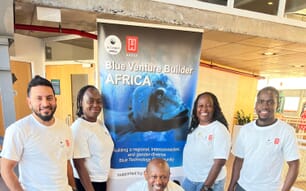Identity
Oreochromis niloticus Linnaeus, 1758 [Cichlidae]
FAO Names: En - Nile tilapia, Fr - Tilapia du Nil, Es - Tilapia del Nilo

Biological features
Body compressed; caudal peduncle depth equal to length. Scales cycloid. A knob-like protuberance absent on dorsal surface of snout. Upper jaw length showing no sexual dimorphism. First gill arch with 27 to 33 gillrakers. Lateral line interrupted. Spinous and soft ray parts of dorsal fin continuous. Dorsal fin with 16 - 17 spines and 11 to 15 soft rays. Anal fin with 3 spines and 10-11 rays. Caudal fin truncated. Colour in spawning season, pectoral, dorsal and caudal fins becoming reddish; caudal fin with numerous black bars.
View SIDP Species fact sheet
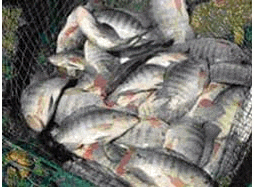

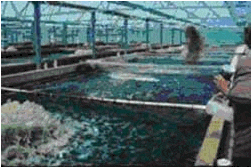
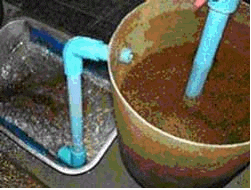
Profile
Historical background
The culture of Nile tilapia (Oreochromis niloticus) can be traced to ancient Egyptian times as depicted on bas-relief from an Egyptian tomb dating back over 4000 years, which showed the fish held in ornamental ponds. While significant worldwide distribution of tilapias, primarily Oreochromis mossambicus, occurred during the 1940s and 1950s, distribution of the more desirable Nile tilapia occurred during the 1960s up to the 1980s. Nile tilapia from Japan were introduced to Thailand in 1965, and from Thailand they were sent to the Philippines. Nile tilapia from Cote d'Ivoire were introduced to Brazil in 1971, and from Brazil they were sent to the United States in 1974. In 1978, Nile tilapia was introduced to China, which leads the world in tilapia production and consistently produced more than half of the global production in every year from 1992 to 2003. The uncontrolled breeding of tilapia in ponds, which led to excessive recruitment, stunting and a low per centage of marketable-sized fish, dampened the initial enthusiasm for tilapia as a food fish. The development of hormonal sex-reversal techniques in the 1970s represented a major breakthrough that allowed male monosex populations to be raised to uniform, marketable sizes. In addition, research on nutrition and culture systems, along with market development and processing advances, led to rapid expansion of the industry since the mid 1980s. Several species of tilapia are cultured commercially, but Nile tilapia is the predominant cultured species worldwide.

Other countries are also significant producers of farmed Nile tilapia but are not recorded on this map for reasons explained within the section of this fact sheet entitled Production.
Habitat and biology
Nile tilapia is a tropical species that prefers to live in shallow water. The lower and upper lethal temperatures for Nile tilapia are 11-12 °C and 42 °C, respectively, while the preferred temperature ranges from 31 to 36 °C. It is an omnivorous grazer that feeds on phytoplankton, periphyton, aquatic plants, small invertebrates, benthic fauna, detritus and bacterial films associated with detritus. Nile tilapia can filter feed by entrapping suspended particles, including phytoplankton and bacteria, on mucous in the buccal cavity, although its main source of nutrition is obtained by surface grazing on periphyton mats. Sexual maturity in ponds is reached at an age of 5-6 months. Spawning begins when the water temperature reaches 24 °C.
The breeding process starts when the male establishes a territory, digs a craterlike spawning nest and guards his territory. The ripe female spawns in the nest, and immediately after fertilisation by the male, collects the eggs into her mouth and moves off. The female incubates the eggs in her mouth and broods the fry after hatching until the yolk sac is absorbed. Incubating and brooding is accomplished in 1 to 2 weeks, depending on temperature. After fry are released, they may swim back into her mouth if danger threatens. Being a maternal mouth brooder, the number of eggs per spawn is small in comparison with most other pond fishes.
Egg number is proportional to the body weight of the female. A 100 g female will produce about 100 eggs per spawn, while a female weighing 600-1 000 g can produce 1 000 to 1 500 eggs. The male remains in his territory, guarding the nest, and is able to fertilise eggs from a succession of females. If there is no cold period, during which spawning is suppressed, the female may spawn continuously. While the female is brooding, she eats little or nothing. Nile tilapia can live longer than 10 years and reach a weight exceeding 5 kg.
Production
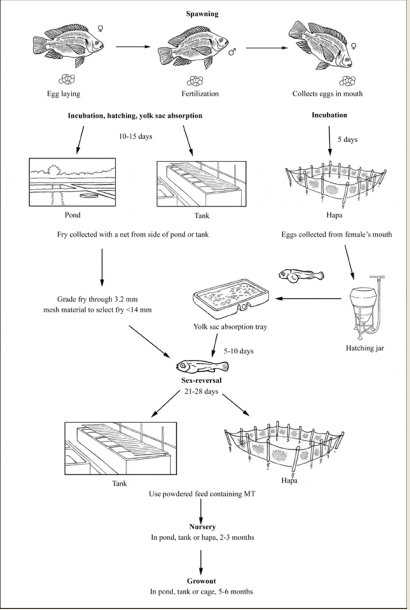
Production systems
Seed supply
Tilapia are asynchronous breeders. Hormones are not used to induce spawning, which occurs throughout the year in the tropics and during the warm season in the subtropics. Breeding is conducted in ponds, tanks or hapas. The stocking ratio for females to males is 1-4:1 with 2 or 3:1 being the most common. The brood fish stocking rate is variable, ranging from 0.3-0.7 kg/m2 in small tanks to 0.2 - 0.3 kg/m2 in ponds. The popular hapa-in-pond spawning system in Southeast Asia uses 100 g brood fish stocked at 0.7 kg/m2. Spawning ponds are generally 2000 m2 or smaller. In Southeast Asia, a common hapa size is 120 m2.
Brood fish are given high quality feed at 0.5-2 per cent of body weight daily. Swim-up fry gather at the edge of a tank or pond and can be collected with fine-mesh nets. Fry collection can begin 10 to 15 days after stocking.
Multiple harvests (six times per day at 5 day intervals) are conducted up to a maximum of 8-10 weeks before pond drainage and a complete harvest is necessary. Tanks must be drained and recycled every 1-2 months because escaped fry are very predaceous on fry from subsequent spawns. Alternatively tanks or ponds are harvested completely after a 2-4 week spawning period. Production of optimum-sized (<14 mm) fry ranges from 1.5 to 2.5 fry/m2/day (20 to 60 fry/kg female/day).
In the South East Asian hapa method, fish are examined individually every 5 days to collect eggs. This system is much more productive, but it is labour intensive. Brood fish are more productive if they are separated by sex and rested after spawning.
Sex-reversal
Commercial tilapia production generally requires the use of male monosex populations. Male tilapia grow approximately twice as fast as females. Therefore, mixed-sex populations develop a large size disparity among harvested fish, which affects marketability. Moreover, the presence of female tilapia leads to uncontrolled reproduction, excessive recruitment of fingerlings, competition for food, and stunting of the original stock, which may not reach marketable size. In mixed-sexed populations, the weight of recruits may constitute up to 70 per cent of the total harvest weight. It is therefore necessary to reverse the sex of female fry.
This is possible because tilapia do become sexually differentiated for several days after yolk sac absorption. If female tilapia receive a male sex hormone (17 a methyltestosterone, MT) in their feed, they will develop as phenotypic males. Fry collected from breeding facilities need to be graded through 3.2 mm mesh material to remove fish that are >14 mm, which are too old for successful sex reversal. Swim-up fry are generally <9 mm. MT is added to a powdered commercial feed or powdered fish meal, containing >40 per cent protein, by dissolving it in 95-100 per cent ethanol, which is mixed with the feed to create a concentration of 60 mg MT/kg feed after the alcohol has evaporated. The alcohol carrier is usually added at 200 ml/kg feed and mixed thoroughly until all the feed is moist. The moist feed is air dried out of direct sunlight, or stirred in a mixer until dried, and then stored under dark, dry conditions.
Androgens break down when exposed to sunlight or high temperatures. Fry are stocked at 3 000 to 4 000/m2 in hapas or tanks with water exchange. Stocking densities as high as 20 000/m2 have been used if good water quality can be maintained. An initial feeding rate of 20-30 per cent body weight per day is gradually decreased to 10-20 per cent by the end of a 3 to 4 week sex-reversal period. Rations are adjusted daily, and feed is administered four or more times per day. If sex-reversal is conducted in hapas, the feed must be of a consistency that allows it to float. Otherwise a considerable amount of feed would be lost as it settles through the bottom of the hapa. Sex-reversed fry reach an average of 0.2 g after 3 weeks and 0.4 g after 4 weeks. The average efficacy of sex-reversal ranges from 95 to 100 per cent depending on the intensity of management.
Nursery
After sex-reversal, fingerlings are generally nursed to an advanced size before they are stocked into grow-out facilities. This procedure increases survival in the grow-out stage and utilises growing space more efficiently. Sex-reversed fingerlings are stocked at approximately 20-25 fish/m2 in small ponds and cultured for 2-3 months to an average size of 30-40 g. The ponds should be filled immediately before stocking to prevent the build-up of predaceous aquatic insects. Final biomass at harvest should not exceed 6000 kg/ha. In ponds, fingerlings are given extruded feed (30 per cent protein) at an initial rate of 8-15 per cent of biomass per day, which is gradually decreased to a final rate of 4-9 per cent per day. A series of small cages (<4 m3) with increasing mesh size can be used to rear advanced fingerlings. Sex-reversed fingerlings can be stocked at a rate of 3 000 fish/m3 and grown for 6 weeks until they average 10 g. Fish of this size can be restocked at 2 500 fish/m3 to produce 25-30 g fingerlings in 4 weeks. These fish can be stocked at 1 500 fish/m3 to produce 50-60 g fingerlings in 4 weeks. A recirculation system stocked at 1 000 fish/m3 will produce 50 g fingerlings in 12 weeks. Fingerlings should be fed 3-4 times daily.
Ongrowing techniques
Ponds
Pond culture of tilapia is conducted with a variety of inputs such as agricultural by-products (brans, oil cakes, vegetation and manures), inorganic fertilisers and feed. Annual fish yields using tilapia in polyculture with carps, high levels of agricultural by-products and good stock management can reach or exceed 5 tonnes/ha.In monoculture tilapia systems, animal manures provide nutrients that stimulate the growth of protein-rich phytoplankton, which is consumed by filter feeding Nile tilapia. The nutrient content of manures varies. Water buffalo manure has much lower nutrient levels compared to duck and chicken manure. Obtaining sufficient nutrient levels from manures poses a danger of oxygen depletion from excessive loading of organic matter. Therefore, a combination of manures with inorganic fertilisers is used in low-input production systems. In Thailand, applying chicken manure weekly at 200-250 kg DM (dry matter)/ha and supplementing it with urea and triple super phosphate (TSP) at 28 kg N/ha/week and 7 kg P/ha/week produces a net harvest 3.4-4.5 tonnes/ha in 150 days at a stocking rate of 3 fish/m² or an extrapolated net annual yield of 8-11 tonnes/ha.
Similar yields are obtained solely with inorganic nutrients if alkalinity, a source of carbon, is adequate. In Honduras yields of 3.7 tonnes/ha are obtained at a stocking rate of 2 fish/m2 with weekly application of chicken litter at 750 kg DM/ha and urea at 14.1 kg N/ha. There is sufficient natural phosphorus. Fertilisation strategies produce fish to a size of 200-250 g in 5 months. Formulated feeds are necessary to produce larger fish and obtain a higher market price.
To reduce production costs for domestic markets in developing countries, two strategies are followed: delayed feeding and supplementary feeding. In Thailand, tilapia are stocked at 3 fish/m2 and grown to 100-150 g in about 3 months with fertiliser alone, and then given supplemental feeding at 50 per cent satiation until the fish reach 500 g. Net harvest averages 14 tonnes/ha, which is equivalent to a net annual yield of 21 tonnes/ha. In Honduras, a yield of 4.3 tonnes/ha can be obtained with weekly application of 500 kg DM/ha of chicken litter and feed application of 1.5 per cent of fish biomass for 6 days a week. However, this management regime is less profitable than the use of chicken litter and urea.
Many semi-intensive farms rely almost exclusively on high quality feeds to grow tilapia in ponds. Male tilapia are stocked at 1-3 fish/m2 and grown to 400-500 g in 5-8 months, depending on water temperature. Normal yields range from 6-8 tonnes/ha/crop but yields as high as 10 tonnes/ha/crop are reported in northeast Brazil, where climate and water quality are ideal. Dissolved oxygen is maintained by exchanging 5-15 per cent of the pond volume daily. Higher yields of large fish (600-900 g) are obtained in other regions by using high quality feed (up to 35 per cent protein), multiple grow-out phases (restocking at lower densities up to three times), high water exchange rates (up to 150 per cent of the pond volume daily) and continuous aeration (up to 20 HP/ha). Fish produced through these expensive methods are generally filleted and sold in export markets.
Floating cages
The culture of Nile tilapia at high densities in floating cages is practiced in large lakes and reservoirs of several countries including China, Indonesia, Mexico, Honduras, Colombia, and Brazil. Mesh size has a significant impact on production and should be 1.9 cm or greater to maintain free circulation of water.
Cage culture offers several important advantages. The breeding cycle of tilapia is disrupted in cages, and therefore mixed-sex populations can be reared in cages without the problems of recruitment and stunting. Eggs fall through the cage bottom or do not develop if they are fertilised. Other advantages include:
- Use of waterbodies that cannot be drained or seined and would otherwise not be suitable for aquaculture.
- Flexibility of management with multiple production units.
- Ease and low cost of harvesting.
- Close observation of fish feeding response and health.
- Relatively low capital investment compared to other culture techniques.
However, there are a number of disadvantages, which include:
- Risk of loss from poaching or damage to cages from predators or storms.
- Less tolerance of fish to poor water quality.
- Dependence on nutritionally complete diets.
- Greater risk of disease outbreaks.
Cages vary widely in size and construction materials. In Brazil, cage volumes and stocking densities range from 4 m3 cages stocked at 200-300 fish/m3 to cages 100 m3 or larger stocked at 25-50 fish/m3. Yields range from 50 kg/m3 in 100 m3 cages to 150 kg/m3 in 4 m3cages. In Colombia, cages range from 2.7 to 45 m3 in volume and are stocked with 30 g sex-reversed male fingerlings and raised to 150-300 g in 6-8 months. The fish are fed extruded feeds with 24-34 per cent crude protein. Streptococcal infections are a problem, and survival averages 65 per cent. Annual yields at final densities of 160-350 fish/m3 are 76-116 kg kg/m3.
Tanks and raceways
Tilapia are cultured in tanks and raceways of varying sizes (10-1 000 m3) and shapes (circular, rectangular, square and oval). An important characteristic of tank design is the effective removal of solid waste; a circular tank with a central drain is the most efficient design. Water exchange ranges from <0.5 per cent of tank volume per day in tanks to 180 exchanges per day in raceways. Low exchange tanks rely on nitrification in the water column to remove toxic nitrogenous waste, while raceways depend on water flow to flush waste from the tank.
One type of tank culture, known as a combined extensive-intensive (CEI) system, or Dekel system, recycles water between culture tanks and large earthen reservoir ponds, which serve as biofilters to maintain water quality. The volumetric ratio between the culture tank and reservoir pond ranges from 1:10 to 1:118 or more. Aeration is employed to increase production in tanks because dissolved oxygen is usually the limiting water quality factor.
The maximum tilapia density in raceways ranges from 160-185 kg/m3, and maximum loading ranges from 1.2-1.5 kg/litre/min. A common production level in raceways is 10 kg/m3/month, as water supplies are often insufficient to attain maximum rates. Production levels are considerably lower in tanks with limited water exchange, but water use efficiency is much higher in these systems.
Recirculation systems
In temperate regions, recirculation systems have been developed to culture tilapia year-round under controlled conditions. Although the design elements of recirculation systems vary widely, the main components of recirculation systems consist of fish rearing tanks, a solids removal device, a biofilter, an aerator or oxygen generator and a degassing unit. Some systems apply additional treatment processes such as ozonation, denitrification and foam fractionation. Rearing tanks are generally circular to facilitate solids removal, although octagonal tanks and square tanks with rounded corners provide a suitable alternative with better space utilisation.
Drum filters are widely employed for solids removal although other devices (bead filters, tube settlers) are often used. Methods used for ammonia removal consist of a flooded moving bed filter, trickling filter, fluidised sand filter or rotating biological contactor. In oxygenated systems, a stage is provided for vigorous aeration to vent carbon dioxide into the environment. Rearing tank retention times are relatively short (e.g. one hour) to remove waste metabolites for treatment and return high quality water. Most recirculation systems are designed to replace 5 to 10 per cent of the system volume each day with new water. This amount of exchange prevents the build-up of nitrates and soluble organic matter that would eventually cause problems.
Production levels in recirculation systems range from 60 to 120 kg/m3 of rearing tank volume, or more. However, the final standing crop is not the best indicator of system efficiency; the maximum daily feed input to a system is a better indicator of both productivity and efficiency. Feed input and other factors that promote production are captured by the production to capacity ratio (P/C), the ratio of system output to maximum carrying capacity. For tilapia, P/C ratios of >4.5 are possible and ratios of >3 may be necessary for profitability. Intensive stock management practices, such as multiple cohort culture with regular partial harvests and restocking, are needed to reach high P/C ratios.
Feed supply
Prepared feeds that provide a complete diet (adequate protein, lipids, carbohydrates, vitamins and minerals) are readily available in developed countries and are also manufactured and available in developing countries with an export market for high quality tilapia products. Some of the main feed ingredients such as soybean meal or fishmeal may be imported. Prepared feeds are often too expensive for the production of tilapia sold in domestic markets in developing countries; however, manures and agricultural by-products are used to produce tilapia cost effectively. In developing countries without a tilapia export market, farmers rely exclusively on manures and agricultural by-products, as prepared feeds are not available.
Harvesting techniques
Complete harvests are necessary in ponds and are accomplished by seining in combination with draining. A complete harvest is not possible by seining alone as tilapia are adept at escaping seine nets. The pond should be dried between production cycles or treated with pesticides to kill tilapia fry to avoid carryover to the next production cycle. Partial harvests of tanks, raceways and recirculation systems, which maximise production, are accomplished with grader bars to remove the largest fish.
Handling and processing
Tilapia must be tested for flavour before they will be accepted for processing and marketing in developed countries. Taste testing is performed by cooking a tilapia fillet without seasonings in a microwave oven for one minute and smelling and tasting it to determine if it has acceptable flavour. If they are off-flavour, they are purged in clean water for 3-7 days in holding tanks or ponds. This procedure is generally not practised in developing countries where the use of spicy seasonings in the cooking process conceals any off-flavour. Tilapia are hauled live to processing plants, killed humanely in ice water and processed manually or mechanically. Dressing percentage depends on condition factor. Nile tilapia with a condition factor of 3.11 will dress at 86 per cent with head, 66 per cent without head, and 33 percent for a skinless fillet.
Production costs
Tilapia are produced most economically in tropical and subtropical countries, which have favourable temperatures for growth. These countries achieve production costs as low as USD 0.55-0.65/kg, which facilitate trade with the leading importer, the USA. A live weight equivalent of 227 300 tonnes of tilapia was exported to the USA in 2004. Imported products consist of whole frozen fish, frozen fillets and fresh fillets. Production costs in temperate countries are too high to compete in these markets. Therefore tilapia produced in temperate countries are generally sold in the live fish market, where higher prices can be obtained.
Diseases and control measures
Diseases can often be avoided by maintaining a high quality environment and reducing handling stress. The major disease problems affecting Nile tilapia are included in the table below.
| DISEASE | AGENT | TYPE | SYNDROME | MEASURES |
|---|---|---|---|---|
| Motile Aeromonas Septicaemia (MAS) | Aeromonas hydrophila & related species | Bacteria | Loss of equilibrium; lethargic swimming; gasping at surface; haemorrhaged or inflamed fins & skin; bulging eyes; opaque corneas; swollen abdomen containing cloudy or bloody fluid; chronic with low daily mortality | KMnO4 at 2-4 mg/litre indefinite immersion or 4-10 mg/litre for 1 hour; antibiotics (need 'extra-label use permit' in the USA), e.g. Terramycin® in feed at 50 mg/kg fish/d for 12-14 d, 21 d withdrawal |
| Vibriosis | Vibrio anguillarum & other species | Bacteria | Same as MAS; caused by stress & poor water quality | Antibiotic in feed |
| Columnaris | Flavobacterium columnare | Bacterium | Frayed fins &/or irregular whitish to grey patches on skin &/or fins; pale, necrotic lesions on gills | KMnO4 as with MAS; indefinite immersion with CuSO4 at 0.5-3 mg/litre, depending on alkalinity |
| Edwardsiellosis | Edwardsiella tarda | Bacterium | Few external symptoms; bloody fluid in body cavity; pale, mottled liver; swollen, dark red spleen; swollen, soft kidney | Antibiotic in feed |
| Streptococcosis | Streptococcus iniae & Enterococcus sp. | Bacteria | Lethargic, erratic swimming; dark skin pigmentation; exophthalmia with opacity & haemorrhage in eye; abdominal distension; diffused haemorrhaging in operculum, around mouth, anus & base of fins; enlarged, nearly black spleen; high mortality. | Antibiotic in feed, e.g. Erythromycin at 50 mg/kg fish/d for 12 d (requires 'extra-label use' permit in the USA) |
| Saprolegniosis | Saprolegnia parasitica | Fungus | Lethargic swimming; white, grey or brown colonies that resemble tufts of cotton; open lesions in muscle | KMnO4 or CuSO4 treatments; use 1 mg/litre of CuSO4 for every 100 mg/litre alkalinity up to 3.0 mg/litre CuSO4; formalin at 25 mg/litre indefinite immersion or 150 mg/litre for 1 h |
| Ciliates | Ichthyophthirius multifiliis; Trichodina & others | Protozoan parasite | Occurs on gills or skin | KMnO4, CuSO4 or formalin treatments |
| Monogenetic trematodes | Dactylogyrus spp.; Gyrodactylus spp | Protozoan parasite | Occurs on body surface, fins or gills | Same as for ciliates |
Statistics
Production statistics
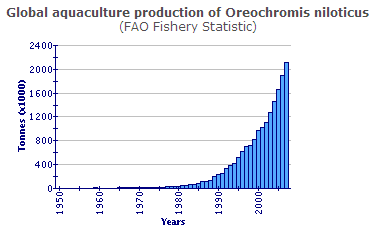
China is by far the largest producer of farmed Nile tilapia. By 2003 annual Chinese production had risen to nearly 806 000 tonnes and Egypt reported a production of nearly 200 000 tonnes in that year, while the Philippines, Thailand and Indonesia produced 111 000 tonnes, 97 000 tonnes and 72 000 tonnes respectively. The other five 'top ten' Nile tilapia producers were the Lao People's Democratic Republic, Costa Rica, Ecuador, Colombia and Honduras. Brazil and Taiwan Province of China are also major producers of Nile tilapia and many others, such as Cuba, Israel, Malaysia, the USA, Viet Nam and Zimbabwe produce significant quantities annually. However, the production of these countries is reported to FAO under the general statistical categories 'tilapias nei' (which may include other tilapia species) and 'freshwater fishes nei'. It is therefore not possible to include their production data in the above chart until the reporting countries refine their statistical returns to FAO; for the same reason these production locations are not shown in the aquaculture geographical distribution section of this fact sheet.
Market and trade
Nile tilapia were introduced to developing countries and cultured on a subsistence level to meet local protein needs. As production techniques improved and off-flavours were controlled, tilapia moved into the mainstream seafood markets of these countries. In highly industrialised countries, small markets for live local tilapia or frozen imports developed among immigrant communities. With the appearance of fresh tilapia fillets from tropical countries, new markets opened in upper echelon restaurants, casual dining restaurant chains, hypermarkets and discount stores. Virtually all casual dining restaurant chains in the US feature tilapia, which are an ideal menu addition due to their reasonable price, year-round supply, mild, delicious flavour and flexibility in preparation. Most Europeans are just discovering tilapia, and great potential exists in Europe for market expansion. China, a major exporter of tilapia, has great potential for market development to supply a rapidly growing middle class. Tilapia is ideally suited to replace carp as the staple of Chinese seafood.
An important component of the growing tilapia industry is the proliferation of product forms. Tilapia exports initially consisted of frozen whole fish from Taiwan Province of China, but the US market preferred fillets, which were initially supplied by Jamaica, Colombia and Costa Rica as a fresh product. Today, fresh or frozen fillets are available in different sizes and packages, as skin-on, skin-off, deep skinned, individually quick frozen, smoked, and sashimi grade, and are treated by carbon monoxide or ozone dipped. Whole or gutted tilapia are still available but are sold primarily in ethnic markets. Interesting by-products have emerged such as leather goods for clothing and accessories, gelatine from skins for time-released medicines and flower ornaments made from dried and coloured fish scales.
Status and trends
Tilapia (including all species) is the second most important group of farmed fish after carps, and the most widely grown of any farmed fish. In 2004 tilapia moved up to the eighth most popular seafood in the USA global production of all species of tilapia is projected to increase from 1.5 million tonnes in 2003 to 2.5 million tonnes by 2010, with a sales value of more than USD 5 billion. Most of this enhanced production is expected to be attributed to Nile tilapia. Some current trends include:
- The development of new faster growing strains through selective breeding techniques.
- Breeding procedures to produce genetically male tilapia (GMT) without direct hormone use.
- Pond polyculture systems.
- Intensive cost-effective recirculation systems.
Main issues
Tilapia grow rapidly on formulated feeds with lower protein levels and tolerate higher carbohydrate levels than many carnivorous farmed species. They can also accept feeds with a higher percentage of plant proteins. It is easy to breed tilapia and culture them intensively and economically. They are relatively resistant to poor water quality and disease. Their ability to over-reproduce in ponds requires the use of male monosex populations. Their hardiness and adaptability to a wide range of culture systems has led to the commercialisation of tilapia production in more than 100 countries. Their widespread consumer appeal will fuel the expansion of the tilapia industry for years to come.
Responsible aquaculture practices
Responsible aquaculture at the production level should be practised in accordance with the main principles of environmental and ecological protection - see Article 9 of the FAO Code of Conduct for Responsible Fisheries
June 2010




